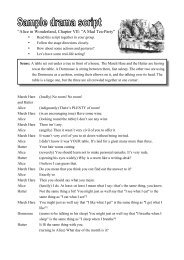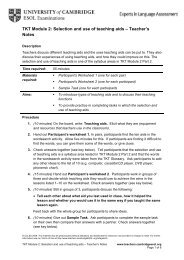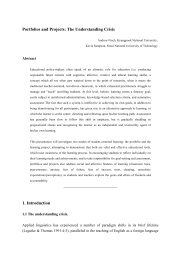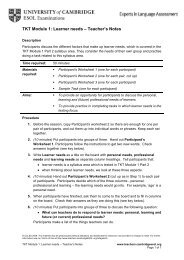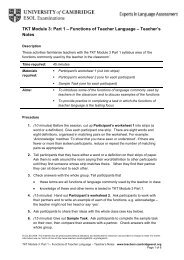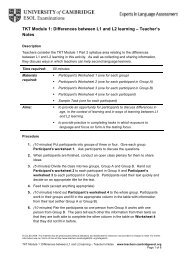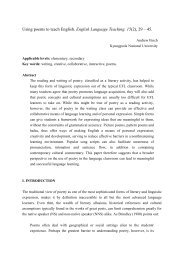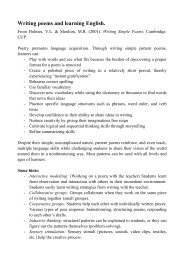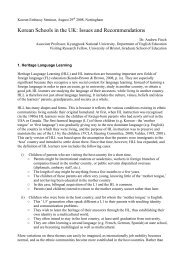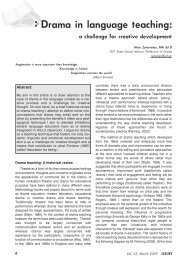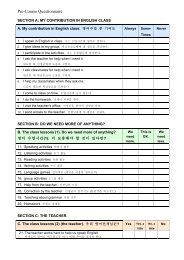Identifying and selecting lesson aims - Finchpark
Identifying and selecting lesson aims - Finchpark
Identifying and selecting lesson aims - Finchpark
Create successful ePaper yourself
Turn your PDF publications into a flip-book with our unique Google optimized e-Paper software.
TKT Module 2: <strong>Identifying</strong> the different components of a <strong>lesson</strong><br />
plan – Teacher’s Notes<br />
Description<br />
Participants review the different components of a <strong>lesson</strong> plan before working with a sample<br />
plan to identify <strong>and</strong> complete missing stages. They discuss their own feelings about <strong>lesson</strong><br />
planning <strong>and</strong> practise a sample exam task from TKT Module 2 Part 1, where this syllabus<br />
area of identifying the different components of a <strong>lesson</strong> plan is assessed.<br />
Time required:<br />
Materials<br />
required:<br />
55 minutes<br />
• Participant’s Worksheet 1 (one for each participant)<br />
• Participant’s Worksheet 2 (one for each participant in Group A)<br />
• Participant’s Worksheet 3 (one for each participant in Group B)<br />
• Sample Task (one for each participant)<br />
Aims: • To introduce the st<strong>and</strong>ard components of a <strong>lesson</strong> plan<br />
Procedure<br />
• To provide practice in completing tasks in which the components of<br />
a <strong>lesson</strong> plan is the testing focus.<br />
1. (10 minutes) Ask participants to think of one thing find easy about <strong>lesson</strong> planning<br />
<strong>and</strong> preparation <strong>and</strong> one thing they find difficult about <strong>lesson</strong> planning. Give them a<br />
minute or two to think about this then ask them to walk around the room sharing the<br />
things they like <strong>and</strong> the things they find difficult with other participants.<br />
When they have finished ask them to share some of the ideas together.<br />
2. (15 minutes) H<strong>and</strong> out Participant’s worksheet 1. In pairs, participants match the<br />
terms for different components of a <strong>lesson</strong> plan in the box (numbered 1–11) with the<br />
descriptions of the components of a <strong>lesson</strong> (lettered A–K).<br />
3. Check answers together (see key below). Tell participants that knowledge of these<br />
terms is tested in TKT Module 2, Part 1.<br />
4. (15 minutes) Explain that participants are going to look at a <strong>lesson</strong> plan for a listening<br />
<strong>and</strong> speaking <strong>lesson</strong>. The topic of the <strong>lesson</strong> <strong>and</strong> the recording for the listening is<br />
‘Extra <strong>lesson</strong>s after school’. Divide the participants into two groups; Group A <strong>and</strong><br />
Group B. Give Group A Participant’s worksheet 2 <strong>and</strong> Group B Participant’s<br />
Worksheet 3. Participants work in their groups <strong>and</strong> fill in the blanks in their plans.<br />
Direct them to the key for the symbols at the bottom of the h<strong>and</strong>out.<br />
5. Re-group the participants into pairs with one from Group A <strong>and</strong> one from Group B.<br />
Explain that they each have the answers to their partner’s gap fill task <strong>and</strong> they can<br />
check their answers by saying the number of the gap <strong>and</strong> asking their partner for the<br />
answer (key also given below).<br />
© UCLES 2009. This material may be photocopied (without alteration) <strong>and</strong> distributed for classroom use provided no charge is made. For further<br />
information see our Terms of Use at http://www.teachers.cambridgeESOL.org/ts/legalinfo<br />
TKT Module 2: <strong>Identifying</strong> the different components of a <strong>lesson</strong> plan – Teacher’s Notes<br />
www.teachers.cambridgeesol.org<br />
Page 1 of 7
6. (10 minutes) Give out Sample Task. Participants complete the sample task on their<br />
own then compare their answers with a partner.<br />
7. Check answers together (see key below).<br />
8. (5 minutes) Round up to summarise points covered. Ask participants:<br />
• What is the TKT Module 2 syllabus area for this <strong>lesson</strong> (identifying the<br />
different components of a <strong>lesson</strong> plan)<br />
• What do you find difficult about this syllabus area (allow participants to<br />
share ideas)<br />
• What did you think of the sample task What did you find difficult (Allow<br />
participants to share views)<br />
© UCLES 2009. This material may be photocopied (without alteration) <strong>and</strong> distributed for classroom use provided no charge is made. For further<br />
information see our Terms of Use at http://www.teachers.cambridgeESOL.org/ts/legalinfo<br />
TKT Module 2: <strong>Identifying</strong> the different components of a <strong>lesson</strong> plan – Teacher’s Notes<br />
www.teachers.cambridgeesol.org<br />
Page 2 of 7
TKT Module 2: <strong>Identifying</strong> the different components of a <strong>lesson</strong><br />
plan – Answer Keys<br />
Key to Participant’s Worksheet 1<br />
1 C 2 I 3 J 4 D 5 A 6 E<br />
7 F 8 H 9 B 10 G 11 K<br />
Key to Participant’s Worksheets 2 <strong>and</strong> 3<br />
Group A/ Participant’s worksheet 2 Group B/ Participant’s worksheet 3<br />
1. Main aim 2. Subsidiary aim<br />
3. Personal aim 4. Assumptions<br />
5. Anticipated problems 6. solutions<br />
7. Lead in 8. to create interest in the topic<br />
9. Pre- teach vocabulary 11. to provide practice of new vocabulary<br />
10. 5 minutes 12. W/C<br />
13. predict the content of the conversation in<br />
pairs<br />
16. Students listen to the recording (twice)<br />
<strong>and</strong> do the comprehension exercise.<br />
14. 3 minutes<br />
15. S<br />
19. SS 17. W/S<br />
20. W/S 18. Students check their answers in pairs<br />
Key to Sample Task<br />
1. B 2. D 3. D 4. A<br />
5. A 6. C 7. D 8. B<br />
© UCLES 2009. This material may be photocopied (without alteration) <strong>and</strong> distributed for classroom use provided no charge is made. For further<br />
information see our Terms of Use at http://www.teachers.cambridgeESOL.org/ts/legalinfo<br />
TKT Module 2: <strong>Identifying</strong> the different components of a <strong>lesson</strong> plan – Answer Keys<br />
www.teachers.cambridgeesol.org<br />
Page 3 of 7
TKT Module 2: <strong>Identifying</strong> the different components of a <strong>lesson</strong><br />
plan – Participant’s Worksheet 1<br />
Match the <strong>lesson</strong> plan components with the descriptions below.<br />
1. Procedure 2. Interaction pattern 3. Timetable fit 4. Stage<br />
5. Main aim 6. Timing 7. Aids 8. Assumptions<br />
9. Personal aim 10. Anticipated problems <strong>and</strong> solutions 11. Subsidiary aim<br />
A. The most important aim, e.g. the teacher’s main aim could be to teach the present<br />
perfect or develop listening skills.<br />
B. What the teacher would like to improve on in his/her teaching, e.g. To reduce the time I spend<br />
writing on the whiteboard.<br />
C. The details of exactly what is going to happen in each stage of a <strong>lesson</strong>, e.g. students<br />
practise the language of complaints in a role-play in pairs.<br />
D. A section of a <strong>lesson</strong>. Lessons work through different steps such as lead-in,<br />
presentation, controlled practice, etc.<br />
E. When teachers plan <strong>lesson</strong>s, they think about how long each activity will take <strong>and</strong> they<br />
usually write this on their plan.<br />
F. The things that a teacher uses in a class, e.g. h<strong>and</strong>outs, pictures, flashcards. When<br />
teachers plan <strong>lesson</strong>s they think about what things they will need.<br />
G. When teachers are planning a <strong>lesson</strong>, they think about what their students might find<br />
difficult about the language or skills in the <strong>lesson</strong> so that they can help them learn more<br />
effectively at certain points in the <strong>lesson</strong>.<br />
H. When teachers think about what they believe their students will know or how they will<br />
behave in a particular <strong>lesson</strong>.<br />
I. The different ways students <strong>and</strong> the teacher work together in class, e.g. student to<br />
student, in pairs or groups or teacher to student, in open class.<br />
J. How a <strong>lesson</strong> fits logically into a sequence of <strong>lesson</strong>s; what goes before a particular<br />
<strong>lesson</strong>, how a <strong>lesson</strong> links to, <strong>and</strong> helps students with, the following <strong>lesson</strong>.<br />
K. The secondary focus of the <strong>lesson</strong>, less important then the main aim. It could be the<br />
language or skills learners must be able to use in order to achieve the main aim.<br />
© UCLES 2009. This material may be photocopied (without alteration) <strong>and</strong> distributed for classroom use provided no charge is made. For further<br />
information see our Terms of Use at http://www.teachers.cambridgeESOL.org/ts/legalinfo<br />
TKT Module 2: <strong>Identifying</strong> the different components of a <strong>lesson</strong> plan – Participant’s Worksheet 1<br />
www.teachers.cambridgeesol.org<br />
Page 4 of 7
TKT Module 2: <strong>Identifying</strong> the different components of a <strong>lesson</strong><br />
plan – Participant’s Worksheet 2<br />
Group A<br />
Fill in the gaps in the <strong>lesson</strong> plan.<br />
Level: Intermediate Length of <strong>lesson</strong>: 50 minutes Topic: extra <strong>lesson</strong>s<br />
1) __________ : to practise the skills of listening for gist <strong>and</strong> listening for detail, <strong>and</strong> to provide<br />
practice in the language of the topic<br />
2) Subsidiary aim: to develop oral fluency<br />
3) __________: to simplify teacher language in class<br />
4) Assumptions: students will be interested in the topic as it is relevant to them<br />
5) _____________<strong>and</strong> 6) solutions: two of the students are less good at listening so the recording<br />
will be difficult. I’ll pair them with stronger students for support<br />
Stages/Time Stage Aims Procedure Int Aids<br />
7) Lead in 8) ____________<br />
Ask the students if any of them do extra<br />
<strong>lesson</strong>s after school, what kind they do <strong>and</strong> W/C<br />
5 minutes _______________<br />
if they enjoy them.<br />
9) _________<br />
5 minutes<br />
Drill<br />
10) _________<br />
Lead in to<br />
recording <strong>and</strong><br />
set task<br />
5 minutes<br />
Recording x1<br />
14) 3 minutes<br />
Feedback<br />
2 minutes<br />
Recording x2<br />
<strong>and</strong> 3<br />
6 minutes<br />
Pair check<br />
3 minutes<br />
Feedback<br />
3 minutes<br />
Class survey<br />
9 minutes<br />
Feedback<br />
4 minutes<br />
to help students<br />
underst<strong>and</strong><br />
vocabulary in the<br />
recording<br />
11) to provide<br />
practice of new<br />
vocabulary<br />
to provide practice<br />
in predicting<br />
content<br />
to provide practice<br />
in listening for gist<br />
Elicit/teach: enjoyable, boring, expensive,<br />
time-consuming, exciting, then write them<br />
on the board.<br />
Choral drill, individual drill <strong>and</strong> ask students<br />
to give me examples of the words in<br />
sentences.<br />
Write the title of the recording on the board:<br />
‘Never waste a moment after school’.<br />
Students 13) ________________________<br />
Students listen to the recording to check<br />
their predictions.<br />
W/C<br />
12)<br />
W/C<br />
W/C<br />
SS<br />
to check answers Students share their answers in open class. W/C<br />
to provide practice<br />
in listening for<br />
detail<br />
to encourage peer<br />
cooperation<br />
H<strong>and</strong> out worksheet. 16) ___________<br />
________________________________<br />
18) Students check their answers in pairs.<br />
15)<br />
S<br />
W/C<br />
19)<br />
____<br />
to check answers Report back on answers. W/C<br />
to develop oral<br />
fluency <strong>and</strong> provide<br />
practice<br />
to allow students to<br />
share views<br />
Put students into groups with a worksheet.<br />
Students carry out a class survey on the<br />
topic in groups.<br />
Report back <strong>and</strong> class discussion of survey<br />
results<br />
Key to symbols:<br />
Int = interaction pattern SSS = students work in groups B = board<br />
W/C = whole class S = students work individually CD = compact disc<br />
SS = student to student<br />
W/S = worksheet<br />
SS<br />
S<br />
W/C<br />
B<br />
B<br />
B<br />
CD<br />
17)<br />
W/S<br />
20)<br />
____<br />
© UCLES 2009. This material may be photocopied (without alteration) <strong>and</strong> distributed for classroom use provided no charge is made. For further<br />
information see our Terms of Use at http://www.teachers.cambridgeESOL.org/ts/legalinfo<br />
TKT Module 2: <strong>Identifying</strong> the different components of a <strong>lesson</strong> plan – Participant’s Worksheet 2<br />
www.teachers.cambridgeesol.org<br />
Page 5 of 7
TKT Module 2: <strong>Identifying</strong> the different components of a <strong>lesson</strong><br />
plan – Participant’s Worksheet 3<br />
Group B Fill in the gaps in the <strong>lesson</strong> plan.<br />
Level: Intermediate Length of <strong>lesson</strong>: 50 minutes Topic: Extra <strong>lesson</strong>s<br />
1) Main aim: to practise the skills of listening for gist <strong>and</strong> listening for detail, <strong>and</strong> to provide practice in<br />
the language of the topic.<br />
2) _______________: to develop oral fluency.<br />
3) Personal aim: to simplify teacher language in class.<br />
4) _______________: students will be interested in the topic as it is topical for them.<br />
5) Anticipated problems <strong>and</strong> 6) _________: two of the students are less good at listening <strong>and</strong> the<br />
recording will be difficult. I’ll pair them with stronger students for support.<br />
Stages/Time Stage Aims Procedure Int Aids<br />
7) ________<br />
5 minutes<br />
9) Pre-teach<br />
vocabulary<br />
5 minutes<br />
Drill<br />
10) 5 minutes<br />
Lead in to<br />
recording <strong>and</strong><br />
set task<br />
5 minutes<br />
Recording x1<br />
14) ________<br />
Feedback<br />
2 minutes<br />
Recording x2<br />
<strong>and</strong> 3<br />
6 minutes<br />
Pair check<br />
3 minutes<br />
Feedback<br />
3 minutes<br />
Class survey<br />
9 minutes<br />
Feedback<br />
4 minutes<br />
8) to create interest<br />
in the topic<br />
to help students<br />
underst<strong>and</strong><br />
vocabulary in the<br />
recording.<br />
11) ___________<br />
______________<br />
to provide practice<br />
in predicting<br />
content.<br />
to provide practice<br />
in listening for gist.<br />
to check answers<br />
to provide practice<br />
in listening for<br />
detail<br />
to encourage peer<br />
cooperation<br />
Ask the students if any of them do extra<br />
<strong>lesson</strong>s after school, what kind they do<br />
<strong>and</strong> if they enjoy them.<br />
Elicit/teach: enjoyable, boring, expensive,<br />
time-consuming, exciting, then write them<br />
on the board.<br />
Choral drill, individual drill <strong>and</strong> ask<br />
students to give me examples of the<br />
words in sentences.<br />
Write the title of the recording on the<br />
board: ‘Never waste a moment after<br />
school’. Students 13) predict the content<br />
of the conversation in pairs<br />
Students listen to the recording to check<br />
their predictions.<br />
Students share their answers in open<br />
class.<br />
H<strong>and</strong> out worksheet. 16) Students listen<br />
to the recording (twice) <strong>and</strong> do the<br />
comprehension exercise.<br />
18) _____________________________<br />
________________________________<br />
W/C<br />
W/C<br />
12)<br />
____<br />
W/C<br />
SS<br />
15)<br />
____<br />
W/C<br />
B<br />
B<br />
B<br />
CD<br />
W/C 17)<br />
____<br />
19)<br />
SS<br />
to check answers Report back on answers W/C<br />
to develop oral<br />
fluency <strong>and</strong> provide<br />
practice<br />
to allow students to<br />
share views<br />
Put students into groups with a<br />
worksheet. Students carry out a class<br />
survey on the topic in groups.<br />
Report back <strong>and</strong> class discussion of<br />
survey results<br />
Key to symbols:<br />
Int = interaction pattern SSS = students work in groups B = board<br />
W/C = whole class S = students work individually CD = compact disc<br />
SS = student to student<br />
W/S = worksheet<br />
SS<br />
S<br />
W/C<br />
20)<br />
W/S<br />
© UCLES 2009. This material may be photocopied (without alteration) <strong>and</strong> distributed for classroom use provided no charge is made. For further<br />
information see our Terms of Use at http://www.teachers.cambridgeESOL.org/ts/legalinfo<br />
TKT Module 2: <strong>Identifying</strong> the different components of a <strong>lesson</strong> plan – Participant’s Worksheet 3<br />
www.teachers.cambridgeesol.org<br />
Page 6 of 7
TKT Module 2: <strong>Identifying</strong> the different components of a <strong>lesson</strong><br />
plan – Sample Task 1<br />
For questions 1–8 match the classroom management strategies with the problems of group<br />
or pair work listed A, B, C <strong>and</strong> D<br />
Mark the correct letter (A, B, C or D) on your answer sheet.<br />
You need to use some options more than once.<br />
Lesson plan components<br />
A<br />
B<br />
C<br />
D<br />
Aim(s)<br />
Personal aim(s)<br />
Teaching aids<br />
Procedure<br />
Information from a <strong>lesson</strong> plan<br />
1 keep the pace of the <strong>lesson</strong> lively<br />
2 students talk about what they did at the weekend<br />
3 tell students to put four photographs in the correct order<br />
4 practise listening for specific information<br />
5 recycle recently taught vocabulary in a different context<br />
6 tape of two people talking about what they did at the weekend<br />
7 students check their answers in pairs<br />
8 make better use of the whiteboard<br />
© UCLES 2009. This material may be photocopied (without alteration) <strong>and</strong> distributed for classroom use provided no charge is made. For further<br />
information see our Terms of Use at http://www.teachers.cambridgeESOL.org/ts/legalinfo<br />
TKT Module 2: <strong>Identifying</strong> the different components of a <strong>lesson</strong> plan – Sample Task 1<br />
www.teachers.cambridgeesol.org<br />
Page 7 of 7



